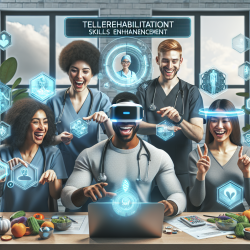Introduction
As practitioners dedicated to improving outcomes for children, understanding the broader implications of traumatic brain injuries (TBI) can significantly enhance our approach. A recent study titled "Long-Term Effects of Low-Level Blast Exposure and High-Caliber Weapons Use in Military Special Operators" provides groundbreaking insights into how subtle changes in eye movements can serve as biomarkers for TBI. This research, while focused on military personnel, offers valuable lessons that can be translated into pediatric care, particularly for children who have experienced head injuries.
The Power of Eye Movements
Eye-tracking technology, a non-invasive and highly sensitive tool, has emerged as a crucial method for assessing neurological function. The study utilized this technology to measure oculomotor behaviors—specifically smooth-pursuit eye movements (SPEM), saccades, and fixations—among military special operators exposed to low-level blasts or high-caliber weapons.
The findings were significant: those exposed to blasts displayed slower eye movements, increased fixation points, and greater deviation from target paths. These inefficiencies in eye movement were strongly correlated with higher symptom severity on concussion assessments.
Implications for Practitioners
For speech-language pathologists and other practitioners, these findings underscore the importance of incorporating oculomotor assessments into our diagnostic toolkit. Here are a few ways to apply these insights:
- Early Detection: Utilize eye-tracking technology to identify potential TBIs in children who have experienced head trauma. Early detection can lead to timely interventions, improving long-term outcomes.
- Objective Assessments: Move beyond subjective evaluations by incorporating objective biomarkers like SPEM into assessments. This approach can enhance the accuracy of diagnoses and tailor interventions more effectively.
- Interdisciplinary Collaboration: Work closely with neurologists and other specialists to interpret eye-tracking data and develop comprehensive care plans for children with suspected TBIs.
Encouraging Further Research
The study highlights the potential for eye-tracking technology to revolutionize TBI diagnosis and management. However, further research is needed to explore its application in pediatric populations. Practitioners are encouraged to collaborate on research initiatives that expand our understanding of oculomotor behavior as a biomarker for TBI in children.
To read the original research paper, please follow this link: Long-Term Effects of Low-Level Blast Exposure and High-Caliber Weapons Use in Military Special Operators.
Conclusion
The intersection of military research and pediatric care offers a unique opportunity to enhance our practices. By leveraging data-driven insights from studies like this, we can improve diagnostic precision and intervention strategies, ultimately leading to better outcomes for children with TBIs. As we continue to explore the capabilities of eye-tracking technology, the future of TBI management looks promising.










